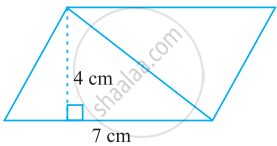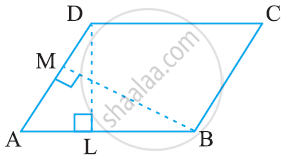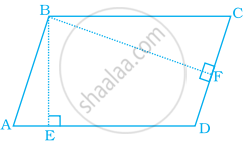Advertisements
Advertisements
Question
The height of the parallelogram is one-fourth of its base. If the area of the parallelogram is 676 sq.cm, find the height and the base
Solution
Let the base of the parallelogram be ‘b’ cm
Given: Height = `1/4` × base
Area of the parallelogram = 676 sq. cm
b × h = 676
b × `1/4`b = 676
b × b = 676 × 4
b × b = 13 × 13 × 4 × 4
b = 13 × 4 cm = 52 cm
Height = `1/4` × 52 cm = 13 cm
Height = 13 cm, Base 52 cm
APPEARS IN
RELATED QUESTIONS
Find the area of the following parallelogram:

PQRS is a parallelogram (see the given figure). QM is the height from Q to SR and QN is the height from Q to PS. If SR = 12 cm and QM = 7.6 cm. Find:
- the area of the parallelogram PQRS
- QN, if PS = 8 cm

DL and BM are the heights on sides AB and AD respectively of parallelogram ABCD (see the given figure). If the area of the parallelogram is 1470 cm2, AB = 35 cm and AD = 49 cm, find the length of BM and DL.

If area of a parallelogram is 29.6 sq cm and its base is 8 cm, find its height.
A parallelogram has sides of 15 cm and 12 cm; if the distance between the 15 cm sides is 6 cm; find the distance between 12 cm sides.
The two sides of the parallelogram ABCD are 6 cm and 4 cm. The height corresponding to the base CD is 3 cm.
Find the
(i) area of the parallelogram.
(ii) the height corresponding to the base AD.

Find the missing values.
| Base | Height | Area |
| 8 cm | 56 sq.m |
In a parallelogram the base is three times its height. If the height is 8 cm then the area is
Area of parallelogram ABCD (see the figure) is not equal to ______.

To find area, any side of a parallelogram can be chosen as ______ of the parallelogram.
